The Limits of Wargaming #1: Morale, Untried Doctrine and Friction
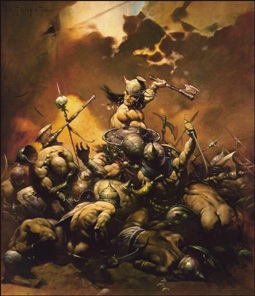
One warm French afternoon in AD 1176, William the Marshal and the Young King found themselves without their comrades on the main street of the little village of Anet. At the other end stood a local knight, intent on capturing them, plus infantry archers and spearmen.
“What shall we do?” asked the Young King (Henry, heir to the throne of England, who I always imagined played by Rick Mayall at his brattiest).
“Charge them by God!” said the Marshal (I tend to cast Russel Crowe).
And so they did.
It was actually a tournament and the archers and spearmen weren’t supposed to be there! The other knight was tight with the French king. There was a good chance that his motives were a bit more than winning a ransom. Even so, the wild young prince and his more mature mentor mounted a two-man cavalry attack against a much larger infantry force.
They should have ended up on the ground, dead or captured. However, the infantry simply routed, and the rest is an amusing anecdote (for which you have to read either the original The History of William Marshal, or else my retelling of the incident in Marshal Versus the Assassins).
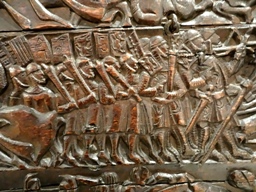
About a century later, 1304, Courtrai, Flanders, a massed army of armored French knights faced off against Flemish townsmen who were armed only with spears and charmingly named gutentags (think ironshod baseball bats with spikes).
Same situation writ large.
Same solution from the knights.
Only this time the infantry didn’t rout.
The front line of French horse balked. The next ran into them. And the next. Horses milled and reared. Knights yelled, flailed with lances and swords. Like a hedgehog with a headache who wasn’t feeling like posing for cute social media memes, the Flemish polearm formation advanced and slaughtered everything in their way.
They called it the Battle of the Golden Spurs for the 500 pairs of gilded knightly spurs collected from the slain chivalry.
From a tabletop gaming point-of-view, these two encounters are boring. In the first, the infantry failed their morale role. In the second, they merely succeeded.
A lot of pre-modern battles do just come down to morale: one side fights harder or shrugs off casualties and routs the other, which it then slaughters as best it can.
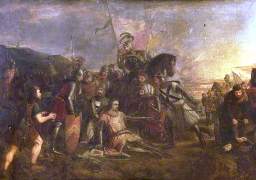
Take, for example Otterburn 1388, where an English night attack on the Scottish camp devolved into the mother of all melees — epic stuff, there are even two poems… Ahem:
For Witherington my heart was woe
That ever he slain should be:
For when both his legs were hewn in two
Yet he kneel’d and fought on his knee
(link)
However, the fact that the English commander was captured and the Scottish one slain, should clue us in that the melee was more about “Rahhh!” than tactics. One suspects the Scottish victory is a good illustration of Sun Tsu’s maxim, “In Death Ground, Fight”.
But wait, there’s more!
At Courtrai — the Golden Spurs — the French knights had every expectation of winning against a ragbag of urban militias clutching spears. and odd looking clubs. What they didn’t realise was that they were up against a new (or revived) technology: the pole arm block. Generally, cavalry can’t break these.
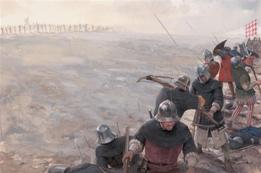
Had he realized this, Robert of Artois, the French commander, might have attempted something clever. Instead he went for the direct approach, which works best if you fully commit, which of course is the same as over-committing if something goes wrong… and the rest is an official Flemish holiday.
So there’s also what I’ll call untried doctrine (by which I mean an untested combination of tactics and technology used to meet a particular challenge).
Then we come to what Von Clausewitz called “friction” and modern military call SNAFU — “Situation Normal, All… erm… Fouled Up.” Small stuff goes wrong and combines to make everything go wrong. Negative synergies for the lose!
At Crecy, 1346 (famous crippling defeat for the home team) the French were well aware of what the English longbow could do: their Scottish allies had experienced it at Halidon Hill in 1333. The French “do something clever” response was an untried doctrine: use armored crossbowmen — Genoese mercenaries — to soften up the English, and “tinned spam” to swamp them — the French fielded an army of stupendous size, perhaps 30,000 men, many of them armoured knights and men-at-arms.
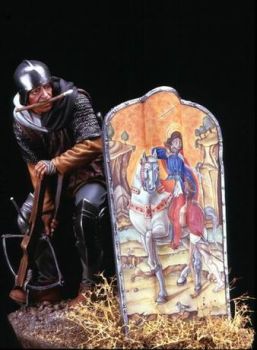
Don’t laugh at them! It very nearly worked. They lost a mere 2,000 men-at-arms, which is of the same order of magnitude most winning sides comfortably sustain through most of history (because risk homeostasis).
The French only lost, and badly, because of “friction.”
The armoured crossbowmen ran into trouble out of the box: The damp weather was bad for the weapons, robbing the strings and horns of tension, thus reducing their power and most importantly, range. They should have been able to pick off the English from comfortably outside their effective range. Instead they had to get closer and take incoming longbow arrows.
That would have been fine if they had had their pavises: door-sized shields that enable you to turn your back on the enemy and reload in relative safety, perhaps enjoying the soothing sensation of arrows thudding uselessly into the thick wood and leather protection.
Unfortunately, they ran into two unintended consequences of the “tinned spam” part of the plan. First, because of the vast numbers involved, what passed for logistics had fallen apart and the Genoese crossbowmen were separated from their baggage, meaning they had to stand and take the English arrowstorm with no protection. No wonder that they wavered and retreated!
Second, so many French combatants had turned out for the battle that the forward pressure (arguably) forced the whole army to charge before the right moment. Possibly the hardy Genoese could have regrouped, retrieved their pavises, or made themselves useful on the flanks. Unfortunately, the “tinned spam” rolled over them, riding them down and trundling off to their own destruction.
Those French men-at-arms who survived the arrow storm to reach the English lines encountered potholes and well-rested English dismounted knights.
Game over.
However, the results could have been very different:
The morale of either side could have failed. The French could have sensibly refused to charge, leading to a forgotten stand off. The English — more likely — could have contemplated the tide of steel about to wash over them and just run away. (And had the crossbows been properly in play, the French might have had an excuse not to charge, and the English good reason to rout.)
The friction could also have worked against the English. They might have been too ill to fight, or King Edward could have succumbed to camp fever and been unable to command. They could have had a problem with their arrow supply. A lucky crossbow bolt might have killed the king. A strong wind could have thrown rain into the faces of the archers. In the close quarters fighting, the Prince of Wales could have been slain and a local route turned into a complete defeat.
Only had friction not neutralized the crossbowmen, the battle would have hinged on the untried doctrine deployed by the French. This was just rock-paper-scissors! Armored crossbowmen could already either out-duel longbowmen or they couldn’t. However, nobody really knew which was true (and, since this was not a proper test, we don’t either).
What about tactics?
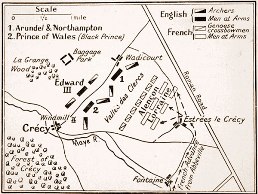
Tactics — feints, flanking movements and manoeuvres, and all that adapting on the fly in the manner beloved of wargamers — didn’t really feature in the battle, which both sides had conspired to reduce to a head-to-head confrontation each thought they could win, much like the Marshal and the Young King at Anet, and just like the French and Flemish at Courtrai.
The battle would only have become tactical if reduced friction had enabled the untried doctrine to partially succeed, meaning one or both sides would have had to redeploy to better utilize or neutralize the crossbows.
So essentially, from a gaming point-of-view, Crecy (along with most medieval battles) is boring.
You could simulate Crecy by making each side roll dice to test first Morale, then Friction. Only if both sides passed the Friction test, you’d roll to see how effective the Untried Doctrine turned out to be, and then only if that didn’t produce a clear winner would you need to get out measuring tape and dice and start moving figures around.
Unfortunately, a good proportion of the most famous Medieval and Ancient battles are like this: decided by a series of tests rather than tactics.
Perhaps this is why our ancestors thought that God’s favor more than generalship decided the results of battles. They’re certainly not something you could simulate interestingly on a tabletop and still keep recognizable.
It gets even worse when you factor in betrayals, surprises and strategic advantage. However, I’ll get to them next time.
M Harold Page is the Scottish author of works such as Swords vs Tanks (Charles Stross: “Holy ****!”). For his take on writing, read Storyteller Tools: Outline from vision to finished novel without losing the magic. (Ken MacLeod: “…very useful in getting from ideas etc to plot and story.” Hannu Rajaniemi: “…find myself to coming back to [this] book in the early stages.”)
A big factor also was that until recently, troops already engaged with the enemy were really difficult to command. Even if the commander has a good view of the battlefield and knows what different units should be doing, how to get them to do it?
You’d send a runner with a message who tries to reach the officer in charge of the unit, if he’s still alive. And even if the message can be delivered, getting hundreds of men fighting for their lives to move as one is really difficult.
That’s really the essence of Clausewitz’s disciple Moltke: No plan survives contact with the enemy. Once combat starts, there is very little a commander can do other than sending reserve troops forward. There’s very little room for tactics.
The big innovation that Moltke introduced to deal with the situation and that gave the Prussian army its big edge was to have the generals give up what little control they had and instead train all unit commanders in tactics and explain the goals of the battle to them. Once the lower level officers down in the field are given free rein to move their units as they see fit without having to wait half an hour to check with the generals if it’s okay you start to see much more tactics. Once you got radio and field officers can directly coordinate with each other things get even more complex and much faster.
I think it was this unit-level independence was one of the things that made Medieval armies harder to control. On the one hand, a knight or captain could rally his men to respond to a situation, thus turning the tide. On the other, he might charge off to settle a feud, or loot, or he might hang back because he felt offended.
One of the things I’ve taken away from my readings on warfare is that there’s a descending hierarchy of control: At the top is strategy, which is designed to put you in a position to utilize sound tactics. In the middle is tactics, which lets you apply the morale, training, and skill of your troops against the enemy. And at the bottom of the hierarchy is what I call “shit happens”… all those unpredictable and uncontrollable things (e.g., a sudden gust of wind or downpour, the Arthurian snake raising its head at the wrong time, an unseen bog) that can sabotage all the best laid plans and best troops.
From a gaming perspective, the first two layers of the hierarchy can be seen as the preparations leading up to that final layer, where the roll of the dice determines the outcome of the fight. You can stack the odds heavily in your favor by optimizing the first 2 layers, but in the end, there’s always some random factor that can change the outcome if you get unlucky.
> From a gaming perspective, the first two layers of the hierarchy can be seen as the preparations leading up to that final layer, where the roll of the dice determines the outcome of the fight. You can stack the odds heavily in your favor by optimizing the first 2 layers, but in the end, there’s always some random factor that can change the outcome if you get unlucky.
Yes. The problem with gaming pre-modern era is that most battles are essentially won or lost before the fighting starts, except for (1) random stuff which the commander can have no tactical control over. (2) And timing of that last charge or whatever.